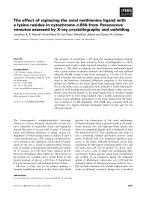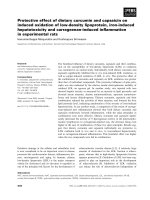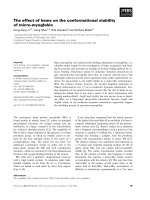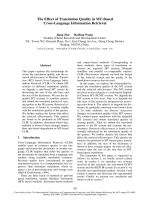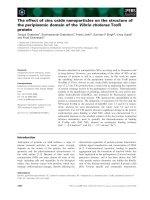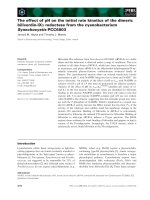Báo cáo khoa học: "The effect of external beam radiotherapy volume on locoregional control in patients with locoregionally advanced or recurrent nonanaplastic thyroid cancer" ppsx
Bạn đang xem bản rút gọn của tài liệu. Xem và tải ngay bản đầy đủ của tài liệu tại đây (363.64 KB, 8 trang )
RESEARC H Open Access
The effect of external beam radiotherapy volume
on locoregional control in patients with
locoregionally advanced or recurrent
nonanaplastic thyroid cancer
Tae Hyun Kim
*†
, Ki-Wook Chung
†
, You Jin Lee
†
, Chan Sung Park, Eun Kyung Lee, Tae Sung Kim, Seok Ki Kim,
Yoo Seok Jung, Jun Sun Ryu, Sang Soo Kim, Kwan Ho Cho, Kyung Hwan Shin
*
Abstract
Purpose: We evaluated outcomes of patients treated with external beam radiotherapy (EBRT) for locoregionally
advanced or recurrent nonanaplastic thyroid cancer and analyzed the effect of EBRT volume on locoregional
control.
Methods: This study included 23 patients with locoregionally advanced or recurrent nonanaplastic thyroid cancer
who were treated with EBRT. Two different EBRT target volumes were executed as follows: 1) limited field (LF, n = 11)
included the primary (involved lobe) or recurrent tumor bed and the positive nodal area; 2) elective field (EF, n = 12)
included the primary (involved lobe) or recurrent tumor bed and the regional nodal areas in the cervical neck and
upper mediastinum. Clinical parameters, such as gender, age, histologic type, recurrence, stage, thyroglobulin level,
postoperative residuum, radioiodine treatment, and EBRT volume were analyzed to identify prognostic factors
associated with locoregional control.
Results: There were no significant differences in the clinical parameter distributions between the LF and EF
groups. In the LF group, six (55%) patients developed locoregional recurrence and three (27%) developed distant
metastasis. In the EF group, one (8%) patient developed locoregional recurrence and one (8%) developed a distant
metastasis. There was a significant difference in locoregional control rate at 5 years in the LF and EF groups (40%
vs. 89%, p = 0.041). There were no significant differences in incidences of acute and late toxicities between two
groups (p>0.05).
Conclusions: EBRT with EF provided significantly better locoregional control than that of LF; however, further
larger scaled studies are warranted.
Introduction
Surgical resection, radioactive iodine treatment (RAI), and
thyroid-stimulating hormone sup pression are considered
as standard treatments for nonanaplastic thyroid cancer.
However, the role of external beam radiotherapy (EBRT)
remains controversial. Despite conflicting data [1-4], a
number of retrospective studies have demonstrated that
EBRT potentially improves locoregional control in patients
with nonanaplastic thyroid cancer who have high risk fea-
tures for locoregional recurrence, such as pT4, lymph
node involvement, micro-/macroscopic positive surgical
margins, extensive extrathyroidal or extranodal extension
at recurrence, or RAI- resistant recurrent disease [5-16].
To date, the current indication, radiation dose, and irra-
diated volume of EBRT have large ly been determined
from retrospective data.
Theoretically, EBRT is directed to the thyroid bed and
draining lymphatics in the cervical neck and upper med-
iastinum to achieve locoregional control and it is recom-
mended [17,18]. But, in clinical practice, EBRT volume
* Correspondence: ;
† Contributed equally
Center for Thyroid Cancer, Research Institute and Hospital, National Cancer
Center, Goyang, Korea
Full list of author information is available at the end of the article
Kim et al. Radiation Oncology 2010, 5:69
/>© 2010 Kim et al; licensee BioMed Central Ltd. This is an Open Access article distributed under the terms of the Creative Comm ons
Attribution License ( censes/by/2.0), which permits unrestricted use, distribution, and reproduction in
any medium, provided the origin al work is properly cited.
has varied among and within studies from the thyroid
bed only to the thyroid bed and regional nodal area in
the cervical neck and upper mediastinum. There are
also differences in the regional nodal areas that need to
be irradiated. The superior and inferior borders of
EBRT volume have been variously defined as follows:
the tip of the mastoid process, the hyoid bone level and
upper level of the thyroid bed; below the suprasternal
notch and the level of the carina, respectively. These
large differences in EBRT volume among those studies
make interpretation difficult and, thus, it is needed to
evaluate the effect of EBRT volume on locoregional con-
trol in nonanaplatic thyroid c ancer patients. Addition-
ally, it is important for patients with nonanaplastic
thyroid cancer to undergo EBRT in clinical practice.
Therefore, we evaluated our institutional outcomes of
patients treated with EBRT for locally advanced or
recurrent nonanaplastic thyroid cancer and analyzed the
effect of EBRT volume on locoregional control.
Methods
Patients
Between February 2004 and February 2008, 25 patients
with locoreg ionally advanced or recurrent nonanaplastic
thyroid cancer were treated with EBRT to the primary
or recurrent site and/or regional nodal area at the
National Cancer Center (NCC), Korea. Of these, two
patients with me du llary carcinoma were e xcluded . This
retrospective study wa s performed in accordance with
the guidelines of the Institutional Review Board of the
NCC. The patients consisted of nineteen (83%) women
and four (17%) men ranging in age from 37 to 76 years
(median, 64 years) (Table 1). All patients had a histolo-
gically confirmed thyroid carcinoma; nineteen had papil-
lary carcinoma, and four had p oorly differentiated
carcinoma, which were defined based on ≥ 5 mitoses/10
high power microscopic fields (400×) and/or tumor
necrosis[19,20]. The stage of all patients were deter-
mined using the American Joint Committee on Cancer
(AJCC) seventh edition staging system [21] and had
more than one of the high risk clinicopathologic fea-
tures, such as the presence of microscopic or gross resi-
dual disease, soft tissue extension o f the primary tumor
(T4), or nodal metastasis (N+). Fifteen (65%) patients
had locoregionally recurrent disease. Five (22%) patients
had a distant metastasis which was controlled with
stable disease at pre-EBRT and these patients’ histologic
type was all papillary.
Table 1 Patient characteristics
Patient Characteristics Distribution,
n (%)
Gender Female 19 (83)
Male 4 (17)
Age (years) Median (range) 64 (37-76)
< 45 2 (8)
45 - 64 10 (44)
≥ 65 11 (48)
KPS 90 10 (43)
80 13 (57)
Histologic type Papillary 19 (83)
Poorly differentiated 4 (17)
Recurrence Primary tumor 8 (35)
Recurrent tumor 15 (65)
T stage at initial diagnosis T1-2 1 (4)
T3 14 (61)
T4 8 (35)
N stage at initial diagnosis N0 4 (17)
N1a 10 (44)
N1b 9 (39)
AJCC Stage at initial
diagnosis
I-II 3 (12)
III 10 (44)
IVA 10 (44)
T stage at pre-EBRT T0-2 3 (13)
T3 3 (13)
T4 17 (74)
N stage at pre-EBRT N0 3 (13)
N1a 4 (17)
N1b 16 (70)
AJCC Stage at pre-EBRT I-III 3 (13)
IVA 14 (61)
IVB 1 (4)
IVC 5 (22)
Tg* level(ng/mL) Median (range) 10 (0.2-1411)
< 10 11 (48)
≥ 10 12 (52)
Thyroid surgery Subtotal thyroidectomy 4 (17)
Total thyroidectomy 19 (83)
Lymph node surgery CND 6 (26)
CND+Unilateral SND/
MRND
14 (61)
CND+Bilateral SND/
MRND
3 (13)
Postoperative residuum No 3 (13)
Microscopic 2 (9)
Macroscopic 18 (78)
Kim et al. Radiation Oncology 2010, 5:69
/>Page 2 of 8
Treatment
Before surgery, a complete medical history, physical
examination, routine blood counts, serum chemistry,
and imaging studies including neck ultrasound (US),
computed tomog raphy (CT) and/or magne tic resonance
imaging (MRI) were performed to accurately evaluate
the extent of the primary or recurrent tumor and re gio-
nal lymph nodes and to assess t he resectability of the
dis ease. Of the 23 patients, 19 (83%) underwent surgery
before EBRT. Eighteen (78%) patients, including 4 with
unresectable disease, had gross residual disease, two
(9%) patients had microscopic residual disease, and
three (13%) patients had n o residual d isease. After sur-
gery, nineteen (93%) patients received a radioactive
iodine (RAI) at a dose of 150 (n = 13) or 200 mCi
(n = 6) and four patients, whose composed of three
poorly differentiated and one papillary carcinoma
patients, did not received a RAI. After surgery and/or
RAI, all patients were treated with EBRT.
All patients underwent CT simulation for EBRT in the
treatment position, which was generally supine, and they
were immobilized from the head to the shoulders using
a thermoplastic mask. Target volumes and the normal
critical tissues, such as the spinal cord, parotid glands,
larynx, and esophagus, were delineated on the treatment
planning CT images. Two different EBRT target
volumes, according to the patient and physician’s prefer-
ences (e.g., age, history of recurrence, anxiety, and com-
pliance for EBRT), were executed as follows: 1) In
limited field group (LF, n = 11), the m edian total dose
of 62.5 Gy (range, 62.5-67.7 Gy) was delivered to the
primary (involved lobe ) or recurrent tumor bed and the
positive nodal area; 2) in elective field group ( EF,
n=12),themediandoseof50Gy(range,44-54Gy)
was delivered to the initial target volume [primary
(involved lobe) or recurrent tumor bed and regional
nodal area in the cervical neck and upper mediastinum]
and then median total dose of 62.5 Gy (range, 60-69
Gy) was delivered to boost target volume (tumor bed
and positive nodal area). Radiation dose values for all
patients were converted to the equivalent dose in 2 G y
fractions using a linear quadratic model, and t he a/b
ratio was 10 for the acute effects on normal tissues and
tumors [22], because the thirteen patients received a
daily fraction size of 2.5 Gy, four patients received 2 Gy
and the three patients received 1.8 Gy. The planning for
the EBRT was done using 3-dimensional conformal
radiotherapy (3DCRT) techniques in 17 (74%) patients
and intensity modulated radiotherapy (IMRT) techni-
ques in 6 (26%) patients who were difficult to obtain the
adequate target coverage within the normal tissues con-
straints with 3DCRT. When the 3DCRT was used for
treating the initial target volume in the EF group, ante-
rior-posterior parallel pair technique, a dominant
weighting (3-4:1) to anterior beam as comp ared to pos-
terior beam together with posterior midline shielding
aft er 36-40Gy, was primarily used. During plannin g, the
mean dose to the parotid gland was constraine d to < 26
Gy, and the total doses to the spinal cord, larynx, and
esophagus were c onstrained to < 45 Gy, < 60 Gy, and
< 60 Gy, respectively.
Evaluation of Locoregional Recurrence and Follow-up
Patient follow-up by a radiation oncologist, endocrinolo-
gist, or thyroid surgeon was performed every 3 months
for the first 2 post-operative years, then every 6 months
for up t o 5 years, and yearly thereafter. For all patients,
follow-up evaluations included a physical examination,
complete blood count, liver function test, serum thyro-
globulin (Tg) level, neck US and/or CT,
131
I whole body
scan, and other radiologic studies, if necessary. Recur-
rence was demonstrated pathologically by surgical resec-
tion, biopsy, or cytology, and/or radiological findings,
which increased in size over time; locoregional recur-
rence was defined as tumor recurrence within a tumor
bed or nodal areas in the cervical neck and the upper
mediastinum, and distant metastasis was defined as any
recurrence outside of the cervical neck and the upper
mediastinum. Locoregional recurrence was subdivided
into infield and outfield recurrences; infield recurrence
was defined as locoregional recurrence within the RT
field; and outfield recurrence was defined as locoregio-
nal recurrence outside of the RT field.
Statistical Analysis
Clinical parameters, such as gender, age (<45, 45-64,
and ≥ 65 years), Karnofsky perf ormance status (90 vs.
80), histologic type (papillary vs. poorly differentiated),
recurrence (primary tumor vs. recurrent tumor), T stage
(T1-2, T3, and T4), N stage (N0, N1a, and N1b), AJCC
stage at diagnosis (I-III vs. I VA) and at pre-EBRT(I-III,
IVA-B, and IVC), Tg level (< 10 ng/mL vs. ≥ 10 ng/
mL), thyroid surgery (subtotal vs. total thyroidectomy),
postoperative residuum (R0-1 vs. R2), radioiodine treat-
ment (no vs. yes), EBRT techniques (3DCRT vs. IMRT),
Table 1 Patient characteristics (Continued)
Radioiodine treatment No 4 (17)
Yes 19 (83)
EBRT volume Limited field 11 (48)
Elective field 12 (52)
EBRT dose (EQD
2
, Gy) Median (range) 62.5 (60-69)
Abbreviation: KPS = Karnofsky performance status; AJCC, American Joint
Committee on Cancer; EBRT, external beam radiotherapy; Tg* = pre-EBRT
serum thyroglobulin; CND = central compartmental neck dissection;
SND = selective neck dissection; MRND = modified radical neck dissection;
EQD
2
, biologically equivalent dose in 2 Gy fractions using a linear quadratic
model (a/b ratio for acute effects on normal tissues and tumors = 10).
Kim et al. Radiation Oncology 2010, 5:69
/>Page 3 of 8
and EBRT volume (LF vs. EF) were considered categor i-
cal variables. Fisher’s exact test was used to compare the
distribution of clinical parameters between the LF and
EF groups. Locoregional control, disease-free survival,
and overall survival were defined as the interval from
the commencement date of EBRT to the date of locore-
gional recurrence d etection, any recurrence detection,
and death, respectively. Local control, disease-free survi-
val, and overall survival probability were calculated
using the Kapla n-Meier method. The analysis for effect
of EBRT volume on locoregional control was performed
by comparing locoregional control rates using the log
rank test. All statistical tests were two-sided and per-
formed using STATA software (version 9.0; Stata Corp.,
College Station, TX, USA). A p value of < 0.05 was con-
sidered statistically significant.
Results
At last follow-up, 19 (83%) patients were alive and 15
(65%) remained free of disease. Of the 23 patients,
locoregional recurrence developed in seven (30%) and
new distant metastasis in four (17%), of which two
patients had simultaneous locoregional recurrence, and
new distant metastasis. The si te of newly developed dis-
tant metastasis included lung (n = 2), bone (n = 1), and
brain (n = 1). All four patients with newly developed
distant metastasis had received a RAI prior to EBRT
and had papillary histology. For all patients, overall sur-
vival, disease-free survival, a nd the locoregional control
rate at 5 years were 75%, 57%, and 61%, respectively.
The median time to locoregional recurrence was 25.3
months (range, 15.5-36.7 months), and the median fol-
low-up time for all patients and for surviving patients
was 41.1 months (range, 8.3-69.4 months) and 43.3
months (range, 24-69.4 months), respectively.
The comparison of clinical parameters between the LF
and EF groups is summarized in Table 2. There were no
significant differences in the distributions of clinical
parameters between the groups. Figure 1 illustrates the
patterns of treatment failure in each group. In the LF
group (n = 11), six (55%) patients developed locoregio-
nal recurrence and three (27%) developed new distant
metastases, of which two had simultaneous locoregional
recurrence and new distant metastasis. Of six patients
who had locoregional recurrence, six (100%) had out-
field failure and one (17%) had infield failure, of which
one patient had simultaneous infield and outfield failure.
In the EF group (n = 12), one (8%) patient developed
locoregional recurrence and one (8%) developed new
distant metastasis. The failure site of one patient who
had locoregional recurrence was infield. There were no
significant differences in overall survival and disease-free
survival rate at 5 years in the LF and EF groups (67% vs.
88%, p = 0.475; 40% vs. 78%, p = 0.113, respectively),
whereas there was a significant difference in locoregio-
nal control rate at 5 years in the LF and EF groups (40%
vs. 89%, p = 0.041) (Figure 2). The infield control rate at
5 years in the LF and EF groups was not significantly
different (88% vs. 89%, p = 0.779). The incidences of
acute and late toxicities between LF and EF field groups
are summarized in Tables 3. There were no significant
differences in incidences of acute and late toxicities
between two groups (p > 0.05). None of the patients in
both groups developed higher than grade 4 acute and
chronic toxicities, and none of patients who developed
locoregional recurrence were sub sequently inoperable
due to EBRT.
Discussion
The role of EBRT in patients with nonanaplastic thyroid
cancer is controversial due to the different perspectives
of surgeons, endocrinologists, nuclear medicine specia-
lists, and radiation oncologists, and also because con-
trolled randomized clinical trials have not been
conducted. However, a number of s tudies have sup-
ported the use of EBRT in populations with high-risk
features for relapse and gross residual disease [5-16].
These studies have demonstrated that patients with
pT4, lymph node involvement, micro-/macroscopic
positive surgical margins, extensive extrathyroidal or
extranodal extension at recurrence, or RAI-resistant
recurrent disease might be candidates for EBRT. The
American Thyroid Association Guideline s Task Force
now recommends EBRT f or gross residual disease not
amendable to surgery or RAI treatment [23]. On the
basis of these studies, nonanaplastic thyroid cancer
patients at our institution are selected for EBRT if they
have high risk features for locoregional recurrence.
When undergoing EBRT for nonanaplastic thyroid
cancer, theoretically, the EBRT volume, directing to the
thyroid bed and draining lymphatics in the cervical neck
and upper mediastinum, is recommended[17,18].
Recently, Arif et al. showed that all mediastinal recur-
rences after EBRT occurred in the superior mediastinum
and recommended that the target volume should
include the thyroid bed, regional neck, and superior
mediastinum [24]. However, in clinical practice, in order
to decrease the toxicities of EBRT and to escalating the
radiation dose for improving the local control, the EBRT
volume, such as inclusion and extent of regional nodal
areas, for nonanaplastic thyroid cancer has varied tre-
mendously among and within centers[5-16] from the
thyroid bed only to the thyroid b ed and regional nodal
areas. These large differences in EBRT volume could
partially explain the differences in the observed locore-
gional control of disease and, in particular, the treat-
ment-related toxicities [11,25-27]. Therefore, it is
required to evaluate the effect of EBRT volume on
Kim et al. Radiation Oncology 2010, 5:69
/>Page 4 of 8
Table 2 Comparison of patient characteristics between the limited field and elective field groups
Patient Characteristics Limited field Elective field p-value
(n = 11) (n = 12)
Gender Female 9 10 1.000*
Male 2 2
Age (years) < 45 0 2 0.582*
45 - 64 5 5
≥ 65 6 5
KPS 90 4 6 0.680*
80 7 6
Histologic type Papillary 11 8 0.093*
Poorly differentiated 0 4
Recurrence Primary tumor 3 5 0.667*
Recurrent tumor 8 7
T stage at diagnosis T1-2 1 0 0.822*
T3 6 8
T4 4 4
N stage at diagnosis N0 3 1 0.179*
N1a 6 4
N1b 2 7
AJCC Stage at diagnosis I-III 7 6 0.680*
IVA 4 6
T stage at pre-EBRT T0-2 2 2 1.000*
T3 1 2
T4 8 8
N stage at pre-EBRT N0 2 1 0.359*
N1a 3 1
N1b 6 10
AJCC Stage at pre-EBRT I-III 1 2 0.640*
IVA-B 7 8
IVC 3 2
Tg level (ng/mL) Median (range) 13.5 (2.7-449) 10.7 (0.2-1411) 0.257
†
Mean ± SD 76.8 ± 137.7 232.3 ± 431.7
< 10 5 6 1.000*
≥ 10 6 6
Thyroid surgery Subtotal thyroidectomy 2 2 1.000*
Total thyroidectomy 9 10
Lymph node surgery CND 3 3 1.000*
CND+Unilateral SND/MRND 7 7
CND+Bilateral SND/MRND 1 2
Postoperative residuum R0-1 2 3 1.000*
R2 9 9
Radioiodine treatment No 1 3 0.590*
Yes 10 9
EBRT dose (EQD
2
, Gy) Median (range) 62.5 (62.5-67.7) 62.5 (60-69) 0.110
†
Mean ± standard deviation 63.3 ± 1.8 65.1 ± 3.1
EBRT techniques 3DCRT 3 3 1.000*
IMRT 8 9
Abbreviation: 3DCRT = 3-dimensional conformal radiotherapy; IMRT = intensity modulated radiotherapy; same as in Table 1.
*Fisher’s exact test.
†
t-test.
Kim et al. Radiation Oncology 2010, 5:69
/>Page 5 of 8
locoregional control in patients with nonanaplastic thyr-
oid cancer. In this study, we reviewed our institutional
outcomes of patients treated with EBRT for locoregion-
ally advanced and recurrent nonanaplastic thyroid can-
cer to evaluate which EBRT volume, such as LF
(primary or recurrent tumor site and positive nodal
area) or EF (the primary or recurrent tumor site and
regional nodal areas in the cervical neck and the upper
mediastinum) should be included
In our study, the locoregional control rate of patients
irradiated with EF was significantly better than those irra-
diated with LF (89% vs. 40%, p = 0.041). However, overall
survival and disease-free survival of the patients irradiated
with EF tended to be higher than those irradiated with LF,
but the differences were not significant (88% vs. 67%, p =
0.475; 78% vs. 40%, p = 0.113, respectively). All patients in
the present study had high risk features, such as
incomplete surgical resection, extensive soft tissue exten-
sion, extranodal extension, poorly differentiated subtypes,
or RAI-resistant recurrent disease. In particular, most
patients (78%) had gross residual disease; however, the
infield control rates at 5 years in the LF and EF groups
were 88% and 89%, respectively (p = 0.779). The infield
(local) control rates in our study are comparable to those
of previous studies [ 5-9,11,12,24,28]. These results sug-
gested that EBRT with LF or EF effectively improved the
local control of nonanaplastic thyroid cancer with high
risk features and EBRT with EF could more effectively
improve not only local control but also locoregional con-
trol than EBRT with LF. This implied that EBRT with EF,
irradiating to tumor bed and regional lymph node area in
the cervical neck and upper mediastinum to eradicate the
macro-/microscopic disease, might be beneficial in nona-
naplastic thyroid cancer patients with high risk features by
improving locoregional control even if local control could
be achieved by other treatments, such as EBRT with LF,
surgery, and/or RAI. However, the present study had a
relatively small sample size (n = 23) with a heterogeneous
population experiencing different postoperative residual
disease includin g recurrent disea se and adjuvant RAI
treatment and had relatively short-term outcomes. There-
fore, further larger-scale studi es should be needed to
determine the role of EBRT and the effect of EBRT
volume on locoregional control for nonanaplastic thyroid
cancer patients with high risk features.
Resistance to routinely performing EBRT for patients
with nonanaplastic thyroid cancer occurs principally for
several reasons. First, the survival benefit of EBRT for
nonanaplastic thyroid cancer is meager. To base a treat-
ment strategy solely on survival data would ignore the
problems associated with locoregional recurrence, such
Figure 1 Patterns of treatment failure in the limited field and
elective field groups.
Figure 2 Locoregional control curves in the limited fi eld and
elective field groups. *log-rank test.
Table 3 Incidences of acute and late toxicity between the
limited field and elective field groups
Toxicity Limited field
(n = 11)
Elective field
(n = 12)
p-
value*
Grade 1/Grade 2/
Grade 3 (n)
Grade 1/Grade
2/Grade 3 (n)
Acute
Skin 5/6/0 8/4/0 0.414
Mucositis 6/5/0 2/10/0 0.089
Xerostomia 4/0/0 7/2/0 0.140
Dysphagia 4/7/0 3/8/1 1.000
Late
Skin 7/0/0 6/0/0 0.680
Xerostomia 2/0/0 4/0/0 0.640
Laryngeal
edema
2/0/0 3/0/0 1.000
*Fisher’s exact test.
Grade determined using National Cancer Institute Common Toxicity Criteria
for Events, version 3.0.
Kim et al. Radiation Oncology 2010, 5:69
/>Page 6 of 8
as the risk of anaplastic transformation in patients with
long-standing locoregional disease, the increased risk of
re-operation, the patient’ s mental angui sh, and the con-
siderable time and expen se of repeated evaluations.
Moreover, the progression of locoregional disease can
significantly affect morbidity and quality of life because
of the proximity to critical organs, including the esopha-
gus, larynx, and spinal cord. For example, Chow et al.
repo rted that locor egional disease was the major contri-
buting cause of death in patients with locally advanced
nonanapl astic thyroid cancer[8]. Therefore, locoregional
control is an important endpoint when examining out-
comes after EBRT in patients with loco regionally
advanced and recurrent nonanaplastic thyroid cancer
with and without metastatic disease, an d EBRT should
be considered for these patients. Second, treatment-
related toxicities are important because of the difficulty
in delivering an adequate dose of EBRT without exceed-
ing the tolerance of critical organs when using conven-
tional two-dimensional EBRT techniques [11,24,27,29].
With the advent of 3 -dimensional (3D) planning sys-
tems, 3DCRT and IMRT techniques improve the target
coverage within acceptable treatment -related toxicities
by limiting the irradiated volume of these normal tissues
[11,27,29]. In our study, acute toxicities were self-
limiting and none of patients developed higher than
grade 3 late toxicities.
Conclusion
In conclusion, w e evaluated the outcomes of EBRT in
patients with locoregionally advanced or recurrent nona-
naplastic thyroid cancer that had high-risk features for
locoregional recurrence and analyzed the effect of EBRT
volume on locoregional control. Our study showed that
EBRT with EF had signifi cant ly better locoregional con-
trol than that of LF and suggested that EBRT with EF
might benefit in nonanaplastic thyroid cancer patients
by improving locoregional control even if local control
could be achieved by other treatments. However, this
study enrolled a small number of patients and had a
relatively short follow-up period. Therefore, further lar-
ger scaled studies with a longer follow-up are required
to accurately define the effect of EBRT and EBRT
volume on locoregional control for locally advanced or
recurrent nonanaplastic thyroid c ancer. In the mean-
while, we recommend EBRT with EF for patients with
locally advanced or recurrent nonanaplastic thyroid
cancer.
Acknowledgements
This work was supported by a National Cancer Center Grant (NCC-1010480).
We thank Dr. Dae Yong Kim of National Cancer Center, Korea for reviewing
the manuscript.
Authors’ contributions
THK and KHS are responsible for the study design. THK, KWK, YJL, CSP, TSK,
SKK, YSJ and JSR collected the clinical data and drafted the manuscript. THK,
KHS, KHC, EKL and SSK revised the manuscript. KWC and YJL collected the
pathologic data and analysis THK, KHS, KWC, and YJL were responsible for
the treatment and evaluation of the patients. KHS and THK provided
oversight of the analysis of data and reviewing of the manuscript. All
authors read and approved the final manuscript.
Competing interests
The authors declare that they have no competing interests.
Received: 25 May 2010 Accepted: 6 August 2010
Published: 6 August 2010
References
1. Lin JD, Tsang NM, Huang MJ, Weng HF: Results of external beam
radiotherapy in patients with well differentiated thyroid carcinoma. Jpn J
Clin Oncol 1997, 27:244-247.
2. Mazzaferri EL, Young RL: Papillary thyroid carcinoma: a 10 year follow-up
report of the impact of therapy in 576 patients. Am J Med 1981,
70:511-518.
3. Samaan NA, Schultz PN, Hickey RC, Goepfert H, Haynie TP, Johnston DA,
Ordonez NG: The results of various modalities of treatment of well
differentiated thyroid carcinomas: a retrospective review of 1599
patients. J Clin Endocrinol Metab 1992, 75:714-720.
4. Biermann M, Pixberg MK, Schuck A, Heinecke A, Kopcke W, Schmid KW,
Dralle H, Willich N, Schober O: Multicenter study differentiated thyroid
carcinoma (MSDS). Diminished acceptance of adjuvant external beam
radiotherapy. Nuklearmedizin 2003, 42:244-250.
5. Kim TH, Yang DS, Jung KY, Kim CY, Choi MS: Value of external irradiation
for locally advanced papillary thyroid cancer. Int J Radiat Oncol Biol Phys
2003, 55:1006-1012.
6. Tsang RW, Brierley JD, Simpson WJ, Panzarella T, Gospodarowicz MK,
Sutcliffe SB: The effects of surgery, radioiodine, and external radiation
therapy on the clinical outcome of patients with differentiated thyroid
carcinoma. Cancer 1998, 82:375-388.
7. Farahati J, Reiners C, Stuschke M, Muller SP, Stuben G, Sauerwein W, Sack H:
Differentiated thyroid cancer. Impact of adjuvant external radiotherapy
in patients with perithyroidal tumor infiltration (stage pT4). Cancer 1996,
77:172-180.
8. Chow SM, Yau S, Kwan CK, Poon PC, Law SC: Local and regional control in
patients with papillary thyroid carcinoma: specific indications of external
radiotherapy and radioactive iodine according to T and N categories in
AJCC 6th edition. Endocr Relat Cancer 2006, 13:1159-1172.
9. Keum KC, Suh YG, Koom WS, Cho JH, Shim SJ, Lee CG, Park CS, Chung WY,
Kim GE: The role of postoperative external-beam radiotherapy in the
management of patients with papillary thyroid cancer invading the
trachea. Int J Radiat Oncol Biol Phys 2006, 65:474-480.
10. Lee N, Tuttle M: The role of external beam radiotherapy in the treatment
of papillary thyroid cancer. Endocr Relat Cancer 2006, 13:971-977.
11. Terezakis SA, Lee KS, Ghossein RA, Rivera M, Tuttle RM, Wolden SL,
Zelefsky MJ, Wong RJ, Patel SG, Pfister DG, et al: Role of external beam
radiotherapy in patients with advanced or recurrent nonanaplastic
thyroid cancer: Memorial Sloan-kettering Cancer Center experience. Int J
Radiat Oncol Biol Phys 2009, 73:795-801.
12. Tubiana M, Haddad E, Schlumberger M, Hill C, Rougier P, Sarrazin D:
External radiotherapy in thyroid cancers. Cancer 1985, 55:2062-2071.
13. O’Connell ME, A’Hern RP, Harmer CL: Results of external beam
radiotherapy in differentiated thyroid carcinoma: a retrospective study
from the Royal Marsden Hospital. Eur J Cancer 1994, 30A:733-739.
14. Brierley JD, Tsang RW: External-beam radiation therapy in the treatment
of differentiated thyroid cancer. Semin Surg Oncol 1999, 16:42-49.
15. Brierley J, Tsang R, Panzarella T, Bana N: Prognostic factors and the effect
of treatment with radioactive iodine and external beam radiation on
patients with differentiated thyroid cancer seen at a single institution
over 40 years. Clin Endocrinol (Oxf) 2005, 63:418-427.
16. Meadows KM, Amdur RJ, Morris CG, Villaret DB, Mazzaferri EL,
Mendenhall WM: External beam radiotherapy for differentiated thyroid
cancer. Am J Otolaryngol 2006, 27:24-28.
Kim et al. Radiation Oncology 2010, 5:69
/>Page 7 of 8
17. Hay ID, Peterson IA: Thyroid Cancer. Clinical radiation oncology
Philadelphia, PA: Elsevier Churchill LivingstoneGunderson LL, Tepper JE , 2
2007, 801-818.
18. Weiss TE, Grigsby PW: Thyroid. Perez and Brady’s principles and practice of
radiation oncology Philadelphia: Wolters Kluwer/Lippincott Williams &
WilkinsHalperin EC, Perez CA, Brady LW , 5 2008, 1055-1075.
19. Hiltzik D, Carlson DL, Tuttle RM, Chuai S, Ishill N, Shaha A, Shah JP, Singh B,
Ghossein RA: Poorly differentiated thyroid carcinomas defined on the
basis of mitosis and necrosis: a clinicopathologic study of 58 patients.
Cancer 2006, 106:1286-1295.
20. Volante M, Landolfi S, Chiusa L, Palestini N, Motta M, Codegone A,
Torchio B, Papotti MG: Poorly differentiated carcinomas of the thyroid
with trabecular, insular, and solid patterns: a clinicopathologic study of
183 patients. Cancer 2004, 100:950-957.
21. Edge SB, American Joint Committee on Cancer: AJCC cancer staging manual
New York: Springer, 7 2010.
22. Joiner MC: A simple alpha/beta-independent method to derive fully
isoeffective schedules following changes in dose per fraction. Int J Radiat
Oncol Biol Phys 2004, 58:871-875.
23. Cooper DS, Doherty GM, Haugen BR, Kloos RT, Lee SL, Mandel SJ,
Mazzaferri EL, McIver B, Pacini F, Schlumberger M, et al: Revised American
Thyroid Association management guidelines for patients with thyroid
nodules and differentiated thyroid cancer. Thyroid 2009, 19:1167-1214.
24. Azrif M, Slevin NJ, Sykes AJ, Swindell R, Yap BK: Patterns of relapse
following radiotherapy for differentiated thyroid cancer: implication for
target volume delineation. Radiother Oncol 2008, 89:105-113.
25. Schuck A, Biermann M, Pixberg MK, Muller SB, Heinecke A, Schober O,
Willich N: Acute toxicity of adjuvant radiotherapy in locally advanced
differentiated thyroid carcinoma. First results of the multicenter study
differentiated thyroid carcinoma (MSDS). Strahlenther Onkol 2003,
179:832-839.
26. Schwartz DL, Lobo MJ, Ang KK, Morrison WH, Rosenthal DI, Ahamad A,
Evans DB, Clayman G, Sherman SI, Garden AS: Postoperative external
beam radiotherapy for differentiated thyroid cancer: outcomes and
morbidity with conformal treatment. Int J Radiat Oncol Biol Phys 2009,
74:1083-1091.
27. Urbano TG, Clark CH, Hansen VN, Adams EJ, Miles EA, Mc Nair H,
Bidmead AM, Warrington J, Dearnaley DP, Harmer C, et al: Intensity
Modulated Radiotherapy (IMRT) in locally advanced thyroid cancer:
acute toxicity results of a phase I study. Radiother Oncol 2007, 85:58-63.
28. Phlips P, Hanzen C, Andry G, Van Houtte P, Fruuling J: Postoperative
irradiation for thyroid cancer. Eur J Surg Oncol 1993, 19:399-404.
29. Nutting CM, Convery DJ, Cosgrove VP, Rowbottom C, Vini L, Harmer C,
Dearnaley DP, Webb S: Improvements in target coverage and reduced
spinal cord irradiation using intensity-modulated radiotherapy (IMRT) in
patients with carcinoma of the thyroid gland. Radiother Oncol 2001,
60:173-180.
doi:10.1186/1748-717X-5-69
Cite this article as: Kim et al.: The effect of external beam radiotherapy
volume on locoregional control in patients with locoregionally
advanced or recurrent nonanaplastic thyroid ca ncer. Radiation Oncology
2010 5:69.
Submit your next manuscript to BioMed Central
and take full advantage of:
• Convenient online submission
• Thorough peer review
• No space constraints or color figure charges
• Immediate publication on acceptance
• Inclusion in PubMed, CAS, Scopus and Google Scholar
• Research which is freely available for redistribution
Submit your manuscript at
www.biomedcentral.com/submit
Kim et al. Radiation Oncology 2010, 5:69
/>Page 8 of 8



